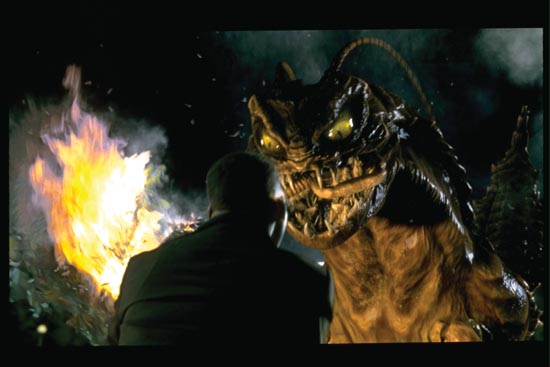In reading Thomas Eisner’s wonderful book, For Love of Insects (2003, Belknap Harvard UP*) I discovered this incredible fact about cockroaches (and, as Dave Barry would say, “I am not making this up”): their nervous systems are so constructed that even days after being decapitated, their reflexes are still accurate and appropriate to stimuli. Here it is in Eisner’s own words:
I had been assisting in the introductory biology course [at Harvard] one summer, and was present on that most horrible occasion when, in the name of neurobiology, the entire class had to take part in the frog-pithing ritual that would yield the spinal preparations needed to demonstrate reflex behavior. The idea was to destroy the brains of these poor frogs–to pith them as the expression goes, meaning to scrape out the cranial cavity with a pin–so that they could then be used to show how they scratched themselves when a droplet of acid is placed on the back. The purpose, I suppose, was to show that some behavior can run its normal course without use of the brain. I hated that lab, and so did many students and most of the professors I knew. So I decided to concoct an alternative preparation.
I had been working on a little research project on roaches–on how they absorb fat from food–which required my killing some individuals by quick decapitation so I could extricate the gut. I had noted the resulting headless roaches remained viable for days and responsive to stimuli. In fact, the headless roach was a vastly more instructive preparation than the pithed frog. The entire body surface appeared to be “mapped out” in the central nervous system of the roach. Wherever I stimulated the animal–I used formic acid, applied with a brush–whether on an appendage or on the body, there always followed a cleansing reflex accurately directed at the stimulated site.** When I stimulated an abdominal segment, the roach scratched that segment. When I stimulated a leg, it brought that leg forward to a position that ordinarily would make it accessible to to the licking action of the mouthparts. When I stimulated an area of its back that it couldn’t reach with a leg, it arched its back upward in an obvious attempt to rub it against an overhanging structure. I eventually published the technique in Turtox News, a journal for teachers, in hopes that it would be adopted and would liberate frogs forever from the experience of being pithed. But no such luck. Pithed frogs are still used in courses to demonstrate reflex behavior, and cockroaches are being avoided, as they are in general. (55-56)
Several thoughts spring to mind on reading this anecdote.
In the first place, and at first glance, it might seem odd that someone who has devoted his life to the study of insects would want them to suffer the same fate as the frogs do: having their brains removed in clumsy fashion by unskilled students in the interests of science. After all, don’t the same “rules” apply to amphibians and insects? Must we be cruel to either of them in order to demonstrate an already-well-proven fact about neurobiology?
However, as Eisner’s perfectly appropriate sense of horror at the sacrifice of the frogs makes clear, replacing frogs with cockroaches is not just an example of vertebrate chauvinism. It makes eminent sense. Frogs are in danger worldwide; wide-scale harvesting of frogs for teaching purposes puts unnecessary strain on their already troubled populations. Cockroaches, on the other hand, are in abundant supply, even if we do risk the occasional extraterrestrial smackdown for our efforts to eradicate them.
Also, it’s a question of pure practicality. Frogs, being vertebrate animals, have a much lower reproductive capacity than almost any insect, by (I’m guessing, here) several orders of magnitude. Cockroaches would be much easier to supply, much easier to replace, and, based on Eisner’s description, demonstrate a much greater range of response to stimuli after decapitation than do frogs. A realistic assessment of the “replacement cost” of the roach certainly suggests that it could supplant the frog in this lab…
Both animals have respectably ancient lineages. The earliest roach-like fossils known date to the Carboniferous era (354-295 million years ago), while the earliest known amphibians arose “only” around 250 million years ago. This 100-million-year difference may not be all that it’s cracked up to be, anyway. According to my fossil insect bible, Grimaldi and Engel,
Roaches are commonly believed to be ancient insects evolving since the Carboniferous, though in fact fossils of modern families are no older than Cretaceous…. Dictyoptera [the group containing modern roaches], in fact, is probably relatively recent, extending to the Jurassic, but for which there is currently very little evidence.
A popular belief in Paleozoic roaches…is understandable because abundant Carboniferous fossils possessed many of the features of modern roaches, including the tegminous forewings and large, shield-like pronotum. However, Paleozoic “roachoids” differed from modern roaches in several key respects, most significantly by possession of a large external ovipositor–a very primitive trait appearing before insects even evolved flight. (227)
So modern roaches and modern amphibians have about equally ancient family trees. According to Wikipedia (it sure would be nice to find a more authoritative source!) protofrogs date to about 250 mya, while the earliest true frog, from the Jurassic period (213-188 mya) actually predates the earliest true roach.
So, let’s all go Washington Irving on Periplaneta americana as private warriors for biological supply companies. Who’s with me? Anyone…? Bueller?
*Thank goodness for the library; I can’t afford every lovely book on bugs I run across!
**Take that, those of you, me included, who thought of the roach as a filthy filthy animal, ein grosses Ungeheuer as Kafka calls the non-roach into which Gregor Samsa metamorphizes in his wonderful tale, Metamorphosis.


1 thought on “Random insect fact: Headless cockroaches do jest fine”